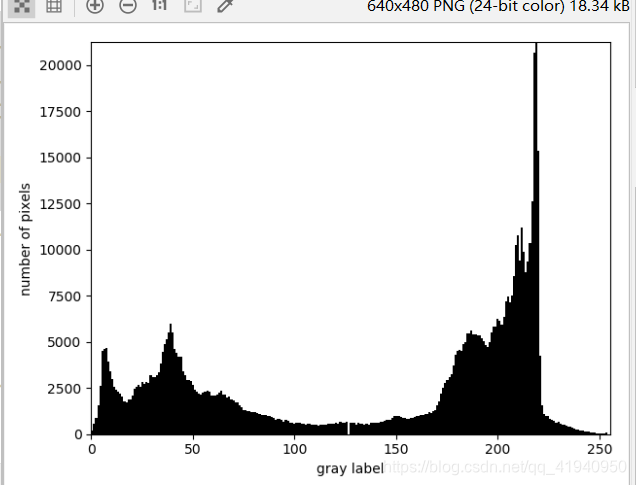线性增强基本算法
python实现线性增强基本算法
import cv2 as cv
import numpy as np
import matplotlib.pyplot as plt
#### 线性增强基本算法
# 绘制直方图函数
def grayHist(img):
h, w = img.shape[:2]
pixelSequence = img.reshape([h * w, ])
numberBins = 256
histogram, bins, patch = plt.hist(pixelSequence, numberBins,
facecolor='black', histtype='bar')
plt.xlabel("gray label")
plt.ylabel("number of pixels")
plt.axis([0, 255, 0, np.max(histogram)])
plt.show()
img = cv.imread("peng.png", 0)
## b可以省略
b = 0
out = -0.5 * img + b
# 进行数据截断,大于255的值截断为255
out[out > 255] = 255
# 数据类型转换
out = np.around(out)
out = out.astype(np.uint8)
# 分别绘制处理前后的直方图
grayHist(img)
grayHist(out)
cv.imshow("img", img)
cv.imshow("out", out)
cv.waitKey()
效果图如下

变换前:
变换后:
分段线性变换
python实现分段线性变换
import cv2 as cv
import numpy as np
import matplotlib.pyplot as plt
# 绘制直方图函数
def grayHist(img):
h, w = img.shape[:2]
pixelSequence = img.reshape([h * w, ])
numberBins = 256
histogram, bins, patch = plt.hist(pixelSequence, numberBins,
facecolor='black', histtype='bar')
plt.xlabel("gray label")
plt.ylabel("number of pixels")
plt.axis([0, 255, 0, np.max(histogram)])
plt.show()
img = cv.imread("peng.png", 0)
img = cv.resize(img, None, fx=0.3, fy=0.3)
h, w = img.shape[:2]
out = np.zeros(img.shape, np.uint8)
for i in range(h):
for j in range(w):
pix = img[i][j]
if pix < 50:
out[i][j] = 0.5 * pix
elif pix < 150:
out[i][j] = 3.6 * pix - 310
else:
out[i][j] = 0.238 * pix + 194
# 数据类型转换
out = np.around(out)
out = out.astype(np.uint8)
grayHist(img)
grayHist(out)
cv.imshow("img", img)
cv.imshow("out", out)
cv.waitKey()
分段线性变换效果图

变换前:
变换后:
线性增强统计量算法
待更新。。。
来源:CSDN
作者:步步星愿
链接:https://blog.csdn.net/qq_41940950/article/details/103462431